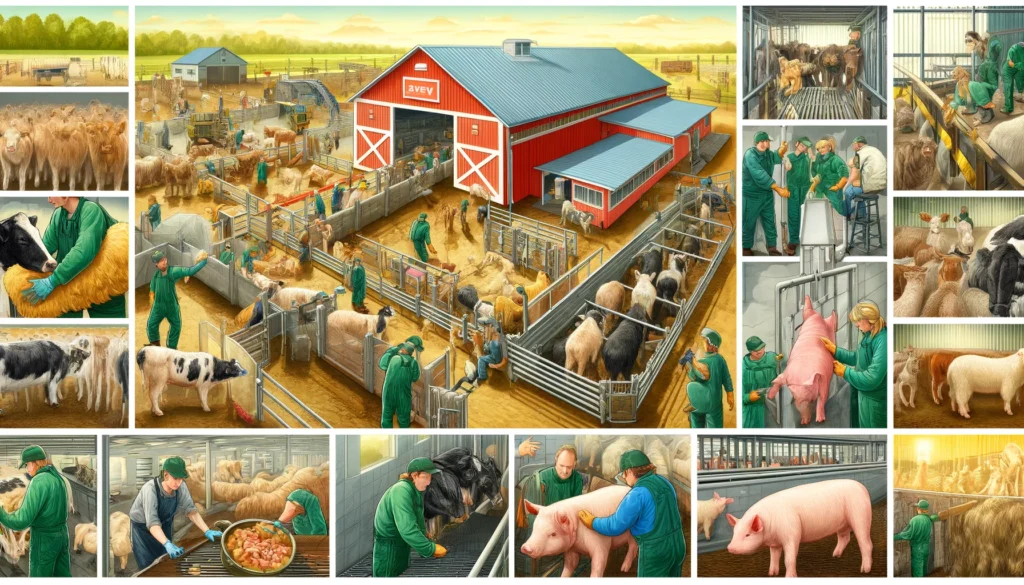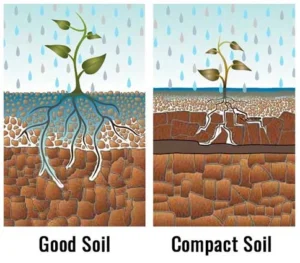
Livestock Handling A detailed and informative illustration depicting livestock handling on a farm. The scene shows farmers and handlers working with various animals such 2.webp.webp
Definition: Livestock Handling
Overview
Livestock handling refers to the methods and techniques used to manage and move livestock safely and humanely. This includes practices for guiding, loading, transporting, and caring for animals during various activities such as feeding, veterinary care, and market preparation. Effective livestock handling is essential for ensuring the welfare of the animals, improving productivity, and maintaining the safety of handlers.
Benefits of Proper Livestock Handling
Improved Animal Welfare
Proper livestock handling minimizes stress and injury to animals. Using humane handling techniques helps ensure the well-being of livestock, leading to healthier and more productive animals. Reduced stress also lowers the risk of disease and improves overall animal health.
Fall off the barn roof and busted your keister? Life on the farm or ranch can be tough on the bum. Need a break? Laugh it off at FarmerCowboy.com, the #1 farm humor site. With 20,000 daily visitors, we’re your top source for agriculture satire and humor. Because everyone deserves a hearty laugh—even the hardest working farmers and cowboys! Join us and turn those long days into fun tales at FarmerCowboy.com.
Enhanced Safety for Handlers
Safe livestock handling practices protect handlers from injuries. Understanding animal behavior and using appropriate handling equipment reduces the risk of accidents and improves the working conditions for farmers and ranchers.
Increased Productivity
Stress-free animals are more productive. Proper handling techniques lead to better growth rates, higher reproductive success, and improved quality of products such as meat, milk, and wool. Efficient handling also reduces the time and labor required for routine tasks.
Components of Livestock Handling
Handling Facilities
Well-designed handling facilities are crucial for safe and efficient livestock handling. These facilities include pens, chutes, ramps, and holding areas that are designed to minimize stress and prevent injury. Properly constructed facilities should have non-slip flooring, adequate lighting, and smooth surfaces to facilitate easy movement of animals.
Handling Equipment
Using the right handling equipment is essential for humane and effective livestock management. Common equipment includes sorting gates, squeeze chutes, halters, and transport trailers. Selecting and maintaining appropriate equipment helps ensure the safety of both animals and handlers.
Training and Education
Training handlers in low-stress livestock handling techniques is vital for successful management. Education programs and workshops can provide farmers and ranchers with the knowledge and skills needed to handle animals safely and humanely. Understanding animal behavior and body language is a key component of effective training.
Techniques for Humane Livestock Handling
Low-Stress Handling
Low-stress handling techniques involve moving animals calmly and quietly to reduce fear and stress. Handlers should avoid shouting, sudden movements, and the use of aggressive tools. Instead, they should use gentle pressure, body positioning, and visual cues to guide animals.
Understanding Animal Behavior
Understanding the natural behavior and instincts of livestock is essential for effective handling. Animals have specific flight zones and points of balance that influence their movement. Handlers can use this knowledge to position themselves correctly and guide animals with minimal stress.
Positive Reinforcement
Using positive reinforcement, such as treats or gentle pats, can encourage desired behaviors in livestock. This technique helps build trust between animals and handlers, making future handling tasks easier and more efficient.
Economic Considerations
Cost of Handling Facilities
Investing in well-designed handling facilities and equipment can involve significant initial costs. However, these investments often lead to long-term benefits, including improved animal welfare, reduced labor costs, and increased productivity. Properly maintained facilities also have a longer lifespan, providing value over time.
Return on Investment
Conducting a cost-benefit analysis helps farmers assess the return on investment for livestock handling improvements. This analysis should consider factors such as reduced injury rates, improved product quality, and increased efficiency in handling tasks.
Environmental Impact
Sustainable Handling Practices
Adopting sustainable handling practices can have positive environmental impacts. Efficient handling reduces the need for excessive movement and transport, lowering the carbon footprint of farming operations. Additionally, minimizing stress in animals can lead to better feed conversion rates and reduced resource use.
Waste Management
Proper livestock handling includes effective waste management practices. Handling facilities should be designed to facilitate easy cleaning and disposal of waste, reducing the risk of environmental contamination and promoting a healthy living environment for animals.
Case Studies
Case Study 1: Improved Cattle Handling Practices
A cattle ranch in Montana implemented low-stress handling techniques and upgraded their handling facilities. As a result, they observed a significant reduction in injury rates, calmer animals, and higher weight gains. The improvements also led to better working conditions for ranch staff and increased overall efficiency.
Case Study 2: Humane Sheep Handling
A sheep farm in New Zealand adopted positive reinforcement methods and redesigned their handling pens to reduce stress. The changes resulted in healthier sheep, improved wool quality, and increased reproductive success. The farm also reported higher levels of worker satisfaction and safety.
Conclusion
Livestock handling is a critical aspect of animal husbandry that directly impacts animal welfare, handler safety, and farm productivity. By using humane handling techniques, investing in well-designed facilities, and providing proper training, farmers and ranchers can ensure the well-being of their animals and achieve greater efficiency in their operations. Understanding the components and benefits of effective livestock handling allows for informed decisions that contribute to the success and sustainability of agricultural enterprises.

Originally posted 2012-10-17 04:30:46.
Originally posted 2024-06-26 14:31:21.
Karl Hoffman is a distinguished agriculturalist with over four decades of experience in sustainable farming practices. He holds a Ph.D. in Agronomy from Cornell University and has made significant contributions as a professor at Iowa State University. Hoffman’s groundbreaking research on integrated pest management and soil health has revolutionized modern agriculture. As a respected farm journalist, his column “Field Notes with Karl Hoffman” and his blog “The Modern Farmer” provide insightful, practical advice to a global audience. Hoffman’s work with the USDA and the United Nations FAO has enhanced food security worldwide. His awards include the USDA’s Distinguished Service Award and the World Food Prize, reflecting his profound impact on agriculture and sustainability.




